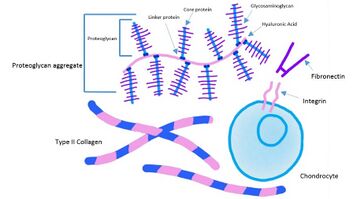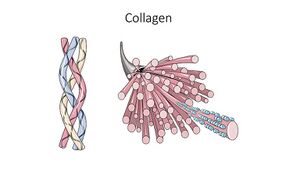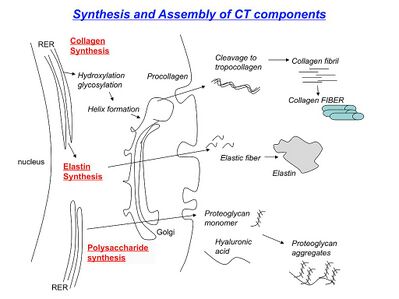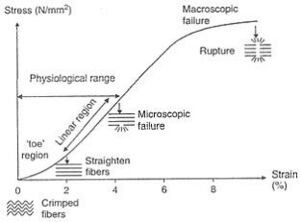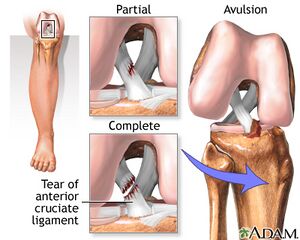Connective Tissue
Original Editor - Lucinda hampton
Top Contributors - Lucinda hampton
Introduction[edit | edit source]
Connective tissue is an umbrella term that encompasses a variety of tissue types, that connect, support and help bind other tissues in the body. Connective tissue divides into three categories: loose connective tissue, dense connective tissue, and specialized connective tissue.
- Loose connective tissue purpose is to hold organs in place and is made up of extracellular matrix and collagenous, elastic and reticular fibers.
- Dense connective tissue, that forms tendons and ligaments, consists of a higher density of collagen fibers.
- Examples of specialized connective tissues are adipose tissue, cartilage, bone, blood, and lymph[1].
Although connective tissue is diverse, all connective tissue consists of three main components:
- Ground substance
- Fibers
- Cells
Together, the ground substance and fibers make up the extracellular matrix (ECM), which is the structural support of surrounding cells throughout the body. The composition of the ECM varies tremendously from organ to organ, which allows for the diverse types of connective tissue[2].
Ground Substance[edit | edit source]
Ground substance is an amorphous sticky material that has a high water content and fills the spaces between cells and fibers, basically forming a gel. It consists of large molecules termed glycosoaminoglycans (GAGs) which link together to forming yet larger molecules called proteoglycans. These molecules are able to absorb large amounts of water, with up to 90% of the extracellular matrix being composed of water. This leads to the extracellular matrix being very effective in being resistant compressive forces. The ground substance also allows for the exchange of cellular nutrients between cells and capillaries .[3][2]
Fibres[edit | edit source]
The fibroblasts secrete the connective tissue fibers. The three types of connective tissue fibers are:
- Collagen fibers - most are type I collagen (most abundant protein in the body). Tensile strength - resistance to stretching
- Elastic fibers - contain elastin and fibrillin. Elasticity - can be stretched, yet still, return to its original length
- Reticular fibers - contain type III collagen. Their function is supportive, form a supporting network in the reticular lamina of the basement membrane found in soft tissues such as the liver, bone marrow, spleen, and lymph nodes.[2][1][4]
The amount of each type generally reflects the function and classification of the particular tissue.[2]
Cells[edit | edit source]
Types of cells in all connective tissue:
- Fibroblasts. The least specialised of all the cells. Responsible for secreting the non-rigid ECM including the fibres: collagen, elastin or fibronectin.
- Adipocytes. Fat storing cells.
- Macrophages, Mast cells and Plasma cells. These are all types of Immune cell.
Cells in specialised forms of connective tissue include: those in specialised connective tissue eg tendons and ligaments, bone and cartilage; haemopoetic tissue; blood; and adipose tissue. Examples of cells present given below.
- Bone contains Osteocytes, and osteoblasts which secrete the type of ECM that makes up bone.
- Cartilage contains chondrocytes and chondroblasts which secrete the type of ECM found in cartilage, respectively.
- Blood vessels contain Endothelial cells and present underneath the epithelium of blood capillaries, are cells called Pericytes, which can divide and provide a source of new fibroblasts, especially following tissue injury[3].
Function[edit | edit source]
Connective tissue has a multitude of varying functions in the body, most importantly providing:
- Resistance to stretch and tear
- Structural support
- Insulation
- Storage of body fuels
- A medium for intercellular exchange.[2]
Examples of Connective tissue:
- In the abdominal cavity, most organs are suspended from the abdominal wall by a membranous band (the mesentery) which is supported by connective tissue, others are embedded in adipose tissue (a form of connective tissue in which the cells are specialized for the synthesis and storage of energy-rich reserves of fat, or lipid).
- The body is supported by a skeleton composed of bone (a type of connective tissue) which provides fantastic resistance to stress owing to its highly ordered laminated structure and to its hardness, which results from deposition of mineral salts in its fibres and ground substance.
- The bones are held firmly together by ligaments, and muscles are attached to bone by tendons, both being dense connective tissue, in which many fibre bundles are associated in parallel array to provide great tensile strength.
- At joints, the articular surfaces of the bones are covered with cartilage, a connective.[5]
Connective Tissue Disorders[edit | edit source]
Connective tissue disorders are a group of disorders involving the protein-rich connective tissue. These disorders can involve the joints, muscles, skin, the eyes, heart, lungs, kidneys, gastrointestinal tract, and blood vessels. There are more than 200 disorders that affect the connective tissue. Causes and specific symptoms vary by the different types.[6]
References[edit | edit source]
- ↑ 1.0 1.1 Kamrani P, Marston G, Jan A. Anatomy, connective tissue. InStatPearls [Internet] 2022 Jan 24. StatPearls Publishing.Available:https://www.ncbi.nlm.nih.gov/books/NBK538534/ (accessed 24.6.2022)
- ↑ 2.0 2.1 2.2 2.3 2.4 Nezwek TA, Varacallo M. Physiology, Connective Tissue.Available;https://www.ncbi.nlm.nih.gov/books/NBK542226/ (accessed 24.6.2022)
- ↑ 3.0 3.1 Histology Guide Connective Tissue Available:https://www.histology.leeds.ac.uk/tissue_types/connective/connective_groundS.php (accessed 24.6.2022)
- ↑ Histology guide Reticular fibres Available:https://histologyguide.com//slideview/MH-078-lymph-node/03-slide-1.html (accessed 24.6.2022)
- ↑ Physiopedia Connective Tissue Disorders (accessed 25.6.2022)
- ↑ Web Md connective tissue disease. Available:https://www.webmd.com/a-to-z-guides/connective-tissue-disease (accessed 25.6.22)


